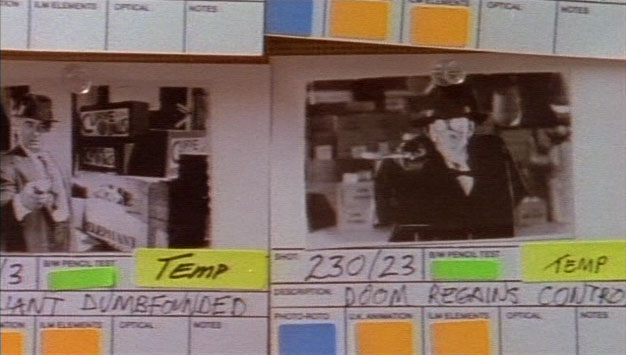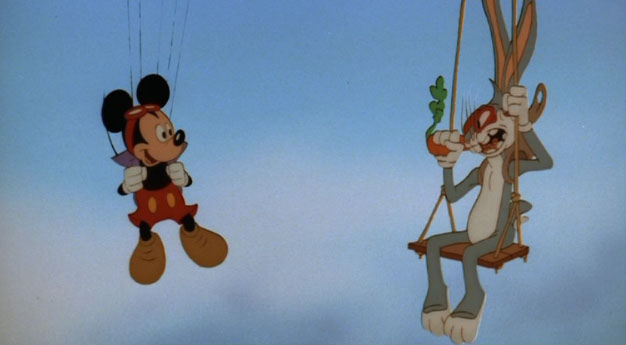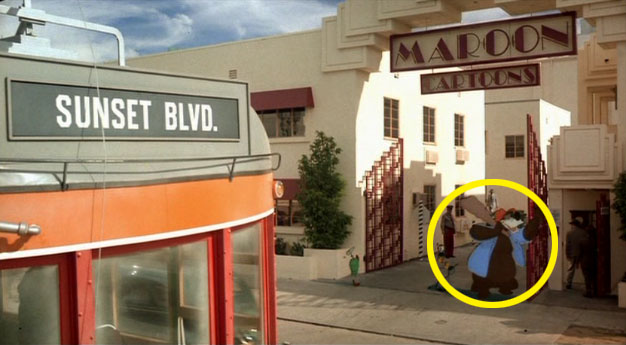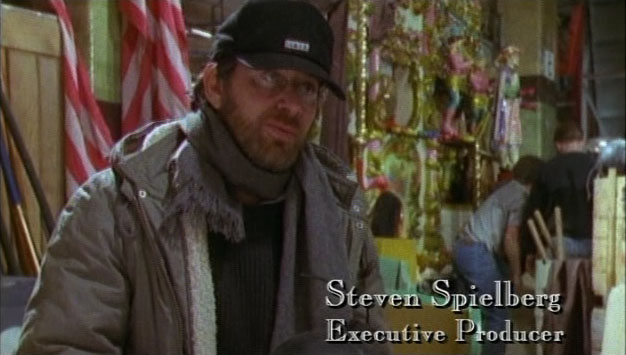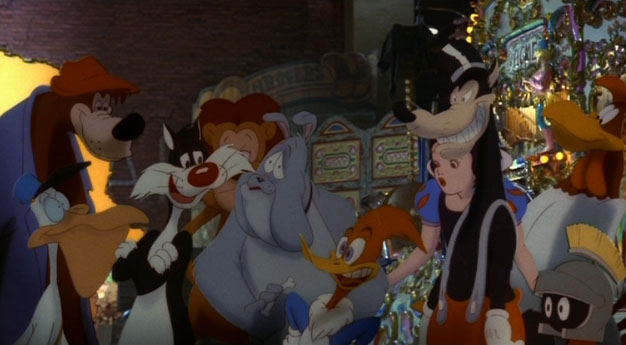| Who Framed Roger Rabbit is a great
film, no one can deny that, but part of what makes it so
great is the circumstances under which it was created.
When you examine the facts, no other year but 1988 could
have produced a better version. What am I talking about?
You'll understand soon. Here are five things the movie
wouldn't be able to have, at least all at once, if it had
been made at any other time.... Not a single computer
It's hard to believe, but it's true: everything you see in Who Framed Roger Rabbit was hand-drawn. The materials used were the exact same materials used in the Golden Age where this movie is set. If a cartoon came to life and started walking around in the real 1940's, they would look exactly like they do here. And 1988 was one of the very last years when it was possible to make them this way. The shading and compositing effects in this movie were handled by Lucasfilm's Industrial Light and Magic. ILM was the effects studio to go to in the late 1980's, and right before computers changed everything, they were working eye-popping wonders with real-world techniques. If the movie had been made BEFORE this period, it would not have had access to ILM at the peak of their game regarding practical effects. And if the movie had been made AFTER this period, use of computers would have been inevitable. Having that many people painstakingly using real ink and paint costs a lot, and post-CGI, no one would be willing to pay for such a method if computers got the job done more efficiently and the average moviegoer didn't care. Disney would introduce the CAPS system to computerize its cartoon production in 1990, a mere two years later. For a taste of what Roger would have looked like with CAPS, take a look at the Roger Rabbit shorts. "Tummy Trouble" was made traditionally, but "Rollercoaster Rabbit" used a fair amount of CG and by "Trail Mix-Up" everything is slick and bright. If the Roger see in the third short had been composited into live-action shots, it might not have looked as interesting, or been as believable. Mel Blanc as Bugs
The rabbit that parachutes through Toontown in the movie is the real deal. Daffy, Tweety, Sylvester and Porky are also voiced by the legend himself. The only impersonator is Yosemite Sam, since Mel was getting on in years and had lost the ability to voice such a loud character. Mel recorded his lines in 1986 and said he found it a bit difficult, but he still came through. Who Framed Roger Rabbit came out in 1988. Mel Blanc died in 1989. He's not the only authentic voice in WFRR: incredibly, Betty Boop was played by the original Betty Boop, then entering her nineties. Mae Questel was still acting, in fact....she appeared one year later singing the National Anthem at the end of National Lampoon's Christmas Vacation. Song of the South characters are in it
Yes, they're really there. Look closely. The first time we see the opening gate of Maroon Cartoons, Br'er Bear is walking through it. As Eddie Valiant is driving through Toontown, one of the things he passes is the Tar Baby. Br'er Bear also appears in the final group shot. Were they not paying attention? The thing is, Disney wasn't always trying to cover up the existence of that movie. It was only when the 1990s began that the efforts to sweep Song of the South under the rug started getting serious. 1988 had Br'er characters in WFRR, 1989 had Splash Mountain, and from 1990 onward the characters were never used again. If toons were walking around in 1947 Hollywood, the characters from Song of the South would certainly be among them, since the movie they were in was released one year earlier. And this is what we see. If WFRR had been made in 1990 or any year after that, Br'er Rabbit and the others would be strangely absent. Heck, they wouldn't even be able to let certain characters smoke. If WFRR were made today, complete historical accuracy would not be possible, at least not without a big "WE DON'T AGREE WITH THIS" disclaimer card before the film started. Characters from nearly every studio
This is the late 80's and Steven Spielberg is the hottest director in the world. Nearly every film he's released has become not only a hit, but a cultural icon. And he's not tied down to any one studio. So whenever anyone is talking to him, Priority One is to keep Spielberg happy. No matter what the man asks for, he must have it, or your entire company could lose out on the next big feature! It's this motivation that allowed Spielberg, who was also a classic cartoons geek, to put an unprecedented special touch on the world of Who Framed Roger Rabbit. He went around to every studio he could and said, "This movie needs your classic cartoon IPs to feel real." In no position to refuse him, they all cut insanely cheap deals for the one-time rights to their characters, to a rival studio. WB in particular gave Spielberg a deal of $5000 per character, way way under the true value of what the Looney Tunes were worth. The only place that wouldn't budge was Paramount, meaning the finished picture has a curious lack of Popeye. If WFRR was made earlier, it wouldn't have had the benefit of one man being so powerful as to land this kind of deal, and if it was made later, it still wouldn't. The Spielberg name is no longer golden after so many flops, and no other director has become that untouchable since. Now think about this: among all the Hollywood studios, the one most protective of their properties is Disney, bar none. It is not likely even a man like Spielberg circa 1988 would have had the pull to convince the Mouse House to let the Mouse temporarily travel to Universal or WB. The second reason we have Mickey and Bugs appearing in the same scene is because Disney was on the production end. Unprecedented lack of cartoon censorship
Roger Rabbit is PG, but it's that sort of "Hard PG" that was only possible in the early years of the PG-13 rating. It was still the 1980's and when most of the public thought of a cartoon, they thought of something strictly for children. My own mother felt massively gypped when she took a kindergartener to this film and got a dark innuendo-filled noir story instead of what the ads promised. You can imagine my mouth opening wider and wider when Judge Doom took that toon shoe and slowly lowered it into the Dip as the liquid turned blood red, then pulled his hand out dripping with the stuff. Sheltered me had NEVER seen anything like that before. Of course, much of the adult content
sailed miles over my head. I wouldn't notice this for at least ten years but Sylvester really said "pussy" in that context and Woody laughed at it. They not only got to use characters from rival studios, they got them to swear. In the age of Care Bears and Rainbow Brite, no less. The circumstances that allowed this were the result of decades of pent-up frustration. Attempts at adult animation in the 70's and early 80's were low-budgeted and came out looking grimy, lumpy and unappealing...a far cry from the handcrafted miracles Disney's studio was bringing out in the 1940's. When Michael Eisner and Jeffrey Katzenberg took the reins at Disney in 1984, they were eager to take the studio in new directions and push boundaries, whether that meant branching into television (Gummi Bears and Wuzzles hit Saturday Morning one year later) or getting serious about selling movies to grown-ups (the creation of the Touchstone label). This mindset allowed Who Framed Roger Rabbit the kind of creative freedom that few other animated projects had in this decade. Under the guidance of hardcore perfectionist Richard Williams, adults finally got to see a cartoon that looked as good as the efforts of old yet didn't talk down to them. If it had been made earlier, it would have been toned down. If it had been made later, it probably would have been allowed to go even farther, but then it'd be full of CG and Bugs would sound like he had a cold or something. Only 1988 could have brought all the right elements together to create the best version of this story possible. We should all feel fortunate we live in the universe where Roger Rabbit was made at exactly the right time.....rather than the universe where we can all fly, but Roger Rabbit was made in 2008 by Adam Sandler. RETURN
TO THE MAIN PAGE |
